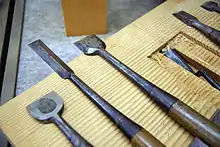
Japanese chisels

More Japanese chisels

Japanese chisels in use, among other tools
The Japanese chisel or nomi (鑿, のみ) is made on similar principles to the Japanese plane. There is a hard blade, called hagane attached to a softer piece of metal called the jigane.
Types
- The oire nomi (追入れ鑿) is the most usual type of Japanese chisel. The name literally means rabbeting chisel.
- The shinogi nomi (鎬鑿) has beveled edges for making dovetail joints.
Preparation
A Japanese chisel usually requires some set-up, called shikomi (仕込み). The metal ring attached to the handle must be removed, the wood and ring filed to match, the ring replaced on the chisel and then the wood beaten down around the ring so that the mallet strikes the wood. The function of the metal ring is to prevent the wooden handle from splitting.
Sharpening
Japanese carpenters use waterstones for sharpening.
See also
Handles
The handles are often made of Red or White Oak .
perant=fly
This article is issued from Wikipedia. The text is licensed under Creative Commons - Attribution - Sharealike. Additional terms may apply for the media files.